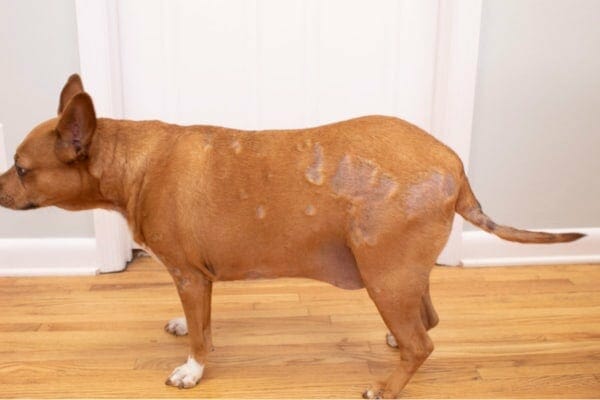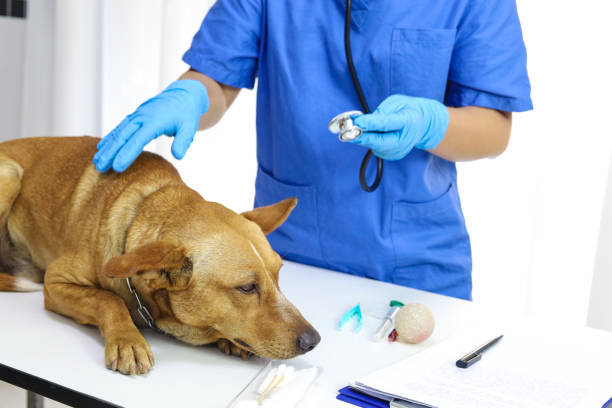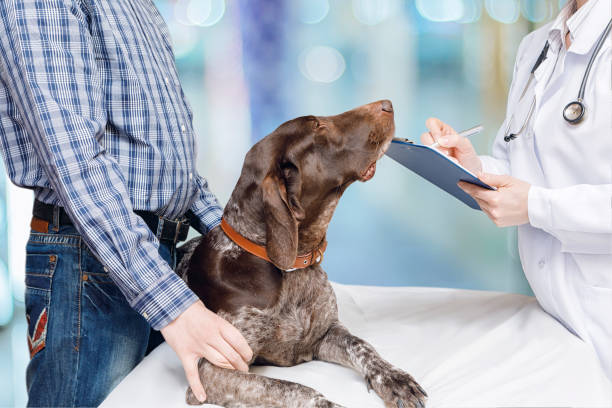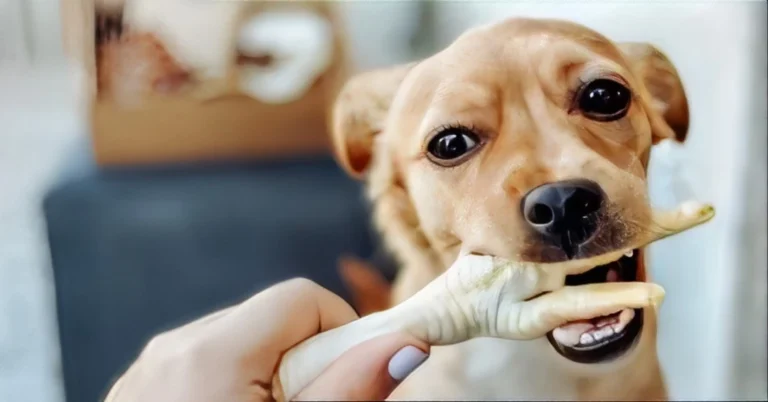Hypothyroidism In Dogs:Causes, Symptoms, Diagnosis, Treatment
Hypothyroidism is a common hormonal imbalance in dogs that results from decreased thyroid hormone production by the thyroid glands located in the neck near the voice box.
It is most commonly seen in middle-aged to older dogs and can cause a variety of symptoms, including fatigue, dull attitude, weight gain, dry hair coat, skin infections, and poor wound healing.
Diagnosis of hypothyroidism is done by taking blood samples to measure hormone levels, and treatment is by administration of oral thyroid hormone supplementation.
While there is generally a rapid improvement in a dog’s activity once treatment is started, determining the right dosage of the thyroid supplement can take time

causes of Hypothyroidism in dogs
Hypothyroidism in dogs can have several causes, including:
Autoimmune Thyroiditis:
In dogs, this is the most typical cause of hypothyroidism. It occurs when the dog’s immune system mistakenly attacks the thyroid gland, leading to inflammation and decreased thyroid function.
Congenital Hypothyroidism:
Some dogs are born with an underdeveloped or absent thyroid gland, leading to hypothyroidism from a young age.
Iodine Deficiency:
Generally, in areas where there is a lack of iodine in the diet, hypothyroidism can occur. This is rare in well-balanced commercial dog foods.
Thyroidectomy or Radioiodine Therapy:
Dogs that have had radioactive iodine treatment for thyroid cancer or have had surgery to remove their thyroid gland may end up hypothyroid.
Medications:
Certain medications, such as sulfa drugs, phenobarbital, and some chemotherapy drugs, can interfere with thyroid function and lead to hypothyroidism.
Other Diseases:
Some other conditions, such as Cushing’s disease or certain types of cancer, can indirectly affect thyroid function and lead to hypothyroidism.
Natural Aging Process:
As dogs age, their thyroid glands may become less efficient, leading to a gradual decline in thyroid hormone production.
In addition, it’s important to consult with a veterinarian for a proper diagnosis and treatment plan if you suspect your dog may have hypothyroidism.
Symptoms of Hypothyroidism in dogs
Hypothyroidism in dogs can cause a variety of symptoms, which can vary in severity. Some common symptoms include:
Weight Gain:
Dogs with hypothyroidism may gain weight despite having a decreased appetite.
Lethargy:
They may appear tired or sluggish and have a reduced interest in physical activity.
Hair Loss and Skin Problems:
Dogs may experience hair loss, especially on their trunk and tail, along with dry, flaky skin and a dull coat.

Cold Sensitivity:
Generally, Hypothyroid dogs may be more sensitive to cold temperatures and seek out warm places to lie down.
Muscle Weakness:
They may have muscle weakness, which can manifest as difficulty getting up or climbing stairs.
Behavioral Changes:
Some dogs may exhibit changes in behavior, such as increased irritability or decreased responsiveness.
Slow Heart Rate:
In severe cases, hypothyroidism can lead to a slow heart rate (bradycardia).
Reproductive Issues:
Female dogs may have irregular heat cycles, while male dogs may experience testicular atrophy.
These symptoms can be subtle and may develop gradually, so it’s important to consult with a veterinarian if you notice any changes in your dog’s health or behavior.
A proper diagnosis can be made through blood tests to measure thyroid hormone levels.
Diagnosis of Hypothyroidism in dogs
Diagnosing hypothyroidism in dogs typically involves a combination of clinical signs, physical examination findings, and laboratory tests. Here are the main steps involved in diagnosing hypothyroidism in dogs:
Clinical Signs and History:

The veterinarian will start by asking about your dog’s medical history and any symptoms you’ve noticed, such as weight gain, lethargy, or skin problems.
Physical Examination:
To look for symptoms of hypothyroidism, such as hair loss, abnormalities of the skin, and changes in body weight, a comprehensive physical examination will be conducted.
Thyroid Function Tests:
The primary test used to diagnose hypothyroidism is a blood test to measure the levels of thyroid hormones, specifically thyroxine (T4) and thyroid-stimulating hormone (TSH). Low T4 levels and high TSH levels are indicative of hypothyroidism.
Thyroid Antibody Testing:
Thyroid antibody testing may be done to confirm the existence of autoimmune illness in situations when autoimmune thyroiditis is suspected.
Response to Therapy:
Generally, In some cases, a tentative diagnosis of hypothyroidism may be made based on clinical signs and response to thyroid hormone replacement therapy.
If the dog shows improvement with treatment, this can support the diagnosis.
Additional Tests:
In some cases, additional tests such as a thyroid ultrasound or a thyroid hormone response test (TRH stimulation test) may be performed to further evaluate thyroid function.
Generally, it is noteworthy that the diagnosis of hypothyroidism can be intricate, and a veterinarian experienced in the intricacies of thyroid function testing in dogs is the best person to interpret test findings.
Treatment of Hypothyroidism in dogs
The primary treatment for hypothyroidism in dogs is lifelong supplementation with synthetic thyroid hormone, usually in the form of a medication called levothyroxine. Here’s an overview of the treatment process:
Diagnosis Confirmation:
Generally, your veterinarian will establish the proper levothyroxine dosage for your dog after diagnosing hypothyroidism from clinical symptoms and blood testing.
Medication Administration:
Usually taken orally once or twice a day, levothyroxine is best taken on an empty stomach. It’s important to follow your veterinarian’s instructions regarding dosage and administration.
Monitoring:
After starting treatment, your dog will need regular follow-up visits to monitor response to therapy. This may include periodic blood tests to check thyroid hormone levels and adjust the medication dosage if needed.
Lifestyle Management:
In addition to medication, maintaining a healthy diet and regular exercise routine is important for managing hypothyroidism in dogs, as obesity can worsen the condition.
Compliance:
It’s important to administer the medication consistently and as prescribed by your veterinarian. Missing doses or stopping treatment abruptly can lead to a recurrence of symptoms.
Annual Check-ups:

Regular check-ups with your veterinarian are important to monitor your dog’s overall health and thyroid function, even if they appear to be doing well on medication.
With proper treatment and management, most dogs with hypothyroidism can lead normal, healthy lives.
However, it’s essential to work closely with your veterinarian to ensure the best possible outcome for your dog.
prevention of Hypothyroidism in dogs
Preventing hypothyroidism in dogs involves a combination of proper nutrition, regular veterinary care, and monitoring for early signs of the disease. Here are some key prevention measures:
Balanced Diet:
Feed your dog a balanced diet that meets their nutritional needs, including appropriate levels of iodine. Avoid feeding excessive amounts of goitrogenic foods (foods that can interfere with thyroid function) such as soy, cabbage, and kale.
Regular Veterinary Check-ups:
Generally, schedule regular veterinary check-ups for your dog, including thyroid hormone level monitoring as recommended by your veterinarian.
Avoidance of Environmental Toxins:
Minimize your dog’s exposure to environmental toxins that can affect thyroid function, such as certain pesticides and flame retardants.
Genetic Screening:
Generally, if you are considering breeding your dog, consider genetic screening for thyroid disorders to help prevent passing on predisposition to hypothyroidism to offspring.
Early Detection and Treatment:
Be aware of the early signs of hypothyroidism, such as weight gain, lethargy, and skin problems, and seek veterinary care promptly if you notice any symptoms.
Maintain a Healthy Weight:
Help your dog maintain a healthy weight through proper diet and regular exercise, as obesity can predispose dogs to hypothyroidism.
While it may not be possible to prevent all cases of hypothyroidism, these measures can help reduce the risk and ensure early detection and management if the disease does develop.
Frequently Asked Questions
With therapy for canine hypothyroidism, the pet’s prognosis is favorable and their lifetime is normal.This is an incurable sickness, however it can be controlled.
Lethargy, hair loss, and flaky skin are examples of clinical abnormalities that may take several weeks or months to go away.
Curing hypothyroidism is not possible. Dogs need to be on thyroid hormone replacement therapy for the remainder of their life.
Generally, the FDA has authorized two medications as replacement treatment for dogs with reduced thyroid function.The active ingredient in both FDA-approved prescription drugs is levothyroxine sodium.
Turnips, Brussels sprouts, broccoli, cabbage, cauliflower, and other plants in the Brassica family contain a substance called goitrin,
which has the ability to inherently slow down thyroid activity.It is not appropriate to offer them to dogs that are hypothyroid.
Conclusion
In conclusion, hypothyroidism is a common hormonal imbalance in dogs that requires lifelong treatment with synthetic thyroid hormone.
In addition, prevention measures include a balanced diet, regular veterinary check-ups, and early detection through awareness of symptoms.
By following these guidelines, dog owners can help manage and mitigate the effects of hypothyroidism, ensuring a healthier life for their pets.






